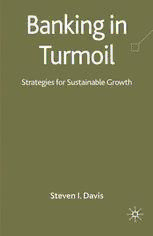
Banking in Turmoil: Strategies for Sustainable Growth PDF
Preview Banking in Turmoil: Strategies for Sustainable Growth
Banking in Turmoil AlsobyStevenI.Davis AFTER THE CREDIT CRISIS: Best Practice in Banking the High Net Worth Individual BANCASSURANCE: The Lessons of Global Experience in Banking and InsuranceCollaboration BANKMERGERSANDACQUISITIONS:TheLessonsofGlobalExperience BANKMERGERS:LessonsfortheFuture BESTPRACTICEINBANKINGTHEAFFLUENT CROSS-SELLING IN RETAIL BANKING: Meeting the Revenue Growth Challenge EXCELLENCEINBANKING INVESTMENTBANKING:AddressingtheManagementIssues LEADERSHIPINCONFLICT:TheLessonsofHistory LEADERSHIPINFINANCIALSERVICES MANAGINGCHANGEINTHEEXCELLENTBANKS THEMANAGEMENTFUNCTIONININTERNATIONALBANKING THEEURO-BANK Banking in Turmoil Strategies for Sustainable Growth Steven I. Davis ManagingDirector,DavisInternationalBankingConsultants ©StevenI.Davis2009 Softcover reprint of the hardcover 1st edition 2009 978-0-230-23571-7 Allrightsreserved.Noreproduction,copyortransmissionofthis publicationmaybemadewithoutwrittenpermission. Noportionofthispublicationmaybereproduced,copiedortransmitted savewithwrittenpermissionorinaccordancewiththeprovisionsofthe Copyright,DesignsandPatentsAct1988,orunderthetermsofanylicence permittinglimitedcopyingissuedbytheCopyrightLicensingAgency, SaffronHouse,6-10KirbyStreet,LondonEC1N8TS. Anypersonwhodoesanyunauthorizedactinrelationtothispublication maybeliabletocriminalprosecutionandcivilclaimsfordamages. Theauthorhasassertedhisrighttobeidentified astheauthorofthisworkinaccordancewiththeCopyright, DesignsandPatentsAct1988. Firstpublished2009by PALGRAVEMACMILLAN PalgraveMacmillanintheUKisanimprintofMacmillanPublishersLimited, registeredinEngland,companynumber785998,ofHoundmills,Basingstoke, HampshireRG216XS. PalgraveMacmillanintheUSisadivisionofStMartin’sPressLLC, 175FifthAvenue,NewYork,NY10010. PalgraveMacmillanistheglobalacademicimprintoftheabovecompanies andhascompaniesandrepresentativesthroughouttheworld. Palgrave®andMacmillan®areregisteredtrademarksintheUnitedStates, theUnitedKingdom,Europeandothercountries. ISBN 978-1-349-31409-6 ISBN 978-0-230-27506-5 (eBook) DOI 10.1057/9780230275065 Thisbookisprintedonpapersuitableforrecyclingandmadefromfully managedandsustainedforestsources.Logging,pulpingandmanufacturing processesareexpectedtoconformtotheenvironmentalregulationsofthe countryoforigin. AcataloguerecordforthisbookisavailablefromtheBritishLibrary. AcatalogrecordforthisbookisavailablefromtheLibraryofCongress. 10 9 8 7 6 5 4 3 2 1 18 17 16 15 14 13 12 11 10 09 Contents ListofFigures vi ListofInterviews vii 1 Introduction 1 2 FromSub-PrimetoQuasi-Nationalization:TheUnique ElementsofaBankingCrisis 4 3 GenericLessonsfromtheTurmoil:WhatCanWeDo BetterintheFuture? 13 4 TheLessonsforFutureRiskManagement 22 5 TheEvolutionofBusinessModels 28 6 TheRoleofLeadershipandCulture 48 7 HowMightFutureBankProfitsandReturnsEvolve? 53 8 CaseStudiesofSuccessfulStrategicModels 60 9 SummaryandOutlook 94 Bibliography 108 Index 109 v List of Figures 2.1 Globalfinancialsystem:builttobubble 6 2.2 TheparticularincentivesandopacityoftheUS sub-primemadeitthe‘SanAndreasfault’ofglobal banking 7 2.3 CDOsbecamehighlyconcentrated... 8 2.4 ...andhighlyleveraged 9 2.5 Inanutshell–thereisnotonecrisisbutthree 9 2.6 Thiscreatedaviciouscirclethatsentthebroader financialmarketintoadownwardspiral 10 2.7 Thisisanunprecedentedcrisis... 11 2.8 Componentsofacrisis–buyersofAAAasset-backed securities(%) 12 5.1 Whatmightawinningportfoliolooklike 47 7.1 Profittrendsfrompreviousbankingcrises 55 8.1 GrowthinGoldmanSachs’bookvaluepershare– 1999to3Q08 65 8.2 ProfileofJPMorganChasenetincomecontributionby lineofbusinessfor2008 73 8.3 Santander’srisk-weightedassetsbygeographicalarea– September2008 77 8.4 Santander’sresponsetothebankingcrisis 79 8.5 BreakdownofStandardChartered’spre-taxprofitby geographyandfunction–firsthalf2008 82 8.6 UBS’swealthmanagementpositioningbynational market 86 8.7 WellsFargo’snationalbranchnetworkfollowing Wachoviaacquisition 91 vi List of Interviews (numberinparenthesisindicatesmorethanoneinterviewee) BancoSantander BlackRockInvestmentManagement BostonConsultingGroup Citigroup(2) CréditSuisse DeutscheBank FinancialInstitutionsConsulting FinancialServicesAuthority(2) FitchRatings(2) Freeman&Co. GoldmanSachs(2) HSBC JPMorganChase(2) KeefeBruyette&Woods McKinsey&Co. OfficeoftheComptrolleroftheCurrency RobinMonro-Davies SandlerO’Neill&PartnersLLP UniCredit UBS vii 1 Introduction The global banking world has been transformed by the crisis which commencedinmid-2007andreachedaclimax–forthetimebeing!– in October 2008 with a firestorm which brought about the collapse of a number of US and other banking institutions and an entry of government ownership and intervention unprecedented since the1930s. Theoverall objectiveof this bookis to provideinsightsintowhat bankers,theirregulators,investors,advisorsandotherconstituencies havelearnedfromthistraumaticexperiencewithaviewtoplanning forthefuture.Itdrawsonaseriesof25in-depthinterviewswithsuch seniorexecutivesaswellastheresearchcarriedoutbyofficialbodies suchastheInternationalMonetaryFund,consultingfirmsandbank analysts. Written in early 2009, it cannot pretend to draw a line under a crisis whose evolution has consistently confounded the so-called experts. This show will run and run! But bank management must manage for the future on the basis of the evidence available. Some business models are destined for the junk heap, while others may evolveinadifferentdirection.Bankregulators,governmentsandrat- ingagenciesmustshapetheirpoliciestoreflectthenewrealities.And perhapsmostinterestingofall,bankinvestorsmustreviewtheirfor- mergrowthmodelforbankstocks,whicharguablyhasbeenamajor driverofthebankingcrisis. More specifically, as strategy consultants our focus in this volume will be on strategic models which should stand the test of time in this new banking world. To anchor this analysis in the real world, 1 2 BankinginTurmoil we profile a number of actual case studies of successful major bank- ing institutionsacross the world. Each is based on a business model which, in the view of our interviewees, has navigated the crisis to datewithsuccessandislikelytocontinuetodoso. In making this selection, we acknowledge that the current crisis hasscarredvirtuallyeverypossiblecandidateforinclusioninthelist, and experience since 2007 has clearly demonstrated the limitations of projecting past results! Yet we believe that the generic lessons are validandofferatleastthebasisonwhichotherbanksmightground theirownstrategy. We commence the body of this analysis with Chapter 2, which briefly summarizes how the crisis evolved from July 2007 until the endof2008withitstransformationofbankingstructuresandown- ership.Ourfocusisonthecontributingfactors,thedatawhichtrack its evolution and the new insights obtained as the crisis evolves. Avid readers of the financial press, in particular the Financial Times, maywishtoskipoverthischapter,butforothersitmaybeauseful explanation of how losses on a segment of the US mortgage market morphed into the worst global banking and economic crisis since theUSmeltdowninthe1930s. Theinsightsfromourinterviewseriesanddataanalysiscommence with Chapter 3, which provides the answers to a central question with which we opened each interview: ‘what have we learned from this experience which is relevant for future planning?’ Our inter- viewbaseincludesseniorbankers(includingtwochairmenofmajor globalbanks),regulatorsintheUSandUK,themajorratingagencies, and experienced bank analysts and management consultants from leadingfirmsinmajorfinancialcentres. The dominant issue in the ‘turmoil’ has been risk management, andChapter4addressesthelessonsofexperiencesincemid-2007.In sum, how might the various constituencies – the banks themselves, investors, rating agencies, governments and regulators – improve their ability to detect and resolve issues which by the end of 2008 have generated over a trillion dollars of losses for the banks alone, quite apart from other financial institutions and investors? While many of these constituencies have yet to agree a new regulatory framework,itspossibleoutlinesarebeginningtotakeshape. Chapter 5 focuses on business models – in effect, the strategic decisions made to allocate resources – as well as perennial issues,
